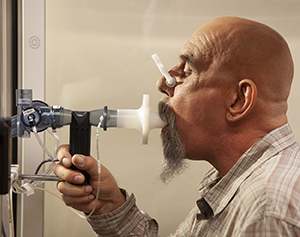Spirometry
Spirometry is a type of breathing test. It measures how much air you can breathe in and out of your lungs. It also measures how fast you breathe air out. It is a painless test often used to find the cause of lung problems.
Why spirometry is done
Spirometry is often done to diagnose asthma or COPD (chronic obstructive pulmonary disease). You may also have this test:
-
To find what’s causing a long-term cough, wheezing, shortness of breath, or chest pain
-
To see if a lung problem such as COPD, asthma, or pulmonary fibrosis has changed over time
-
To find out how your breathing medicines such as bronchodilators are working
-
To check your lungs to help plan for a surgery
-
To evaluate your lung function after exposure to dusts, chemicals, or other irritants
In some cases, you may have to wait to have a spirometry test. Tell your healthcare provider if you have had:
-
A heart attack in the last 30 days
-
A recent surgery on your eyes, chest, or belly
-
A collapsed lung
-
A lung infection called tuberculosis
How spirometry is done
Before the spirometry test, your healthcare provider will tell you how to get ready. Follow your healthcare provider's instructions. Ask questions if something isn't clear.
Your healthcare provider may tell you to stop using certain inhalers or taking certain medicines before the test. If you use a short-acting inhaler, you may be told not to use it for 6 to 8 hours before the test, if possible.
Here are some tips to follow:
-
Don't smoke for at least 6 hours beforehand, if you smoke.
-
Don't eat a big meal for 2 hours before the test.
-
Don't wear tight clothing. It may prevent you from taking deep breaths.
The spirometry test will take about 30 minutes. During the test, you can expect the following:
-
You will be asked to sit. You will put on a nose clip. The clip pinches your nose closed. This makes it so you can only breathe through your mouth.
-
You will be given a plastic mouthpiece. This mouthpiece attaches to the spirometry machine. You will close your lips tightly around the mouthpiece.
-
With the mouthpiece in place, you will take as deep a breath as you can. Then you will blow out as hard and as fast as you can.
-
You will do this deep breathing at least 3 times. This is to make sure the results are good.
-
As part of the test, your healthcare provider may give you medicine to help open up your airways. To take this medicine, you will breathe in through an inhaler.
-
After you take the medicine, you will repeat the spirometry test. This will help show whether the medicine has helped your breathing.

What happens after spirometry
After the test, you can go back to your normal activities. Your healthcare provider will talk with you about the results. He or she may prescribe you medicine to help you breathe better. You may need to do the spirometry test again at some later time. Repeat testing can help check your lung function over time.
Risks of spirometry
Spirometry is often a painless test. But tell your healthcare provider if you feel any discomfort. Breathing in and out fast and hard can cause:
-
Tiredness (fatigue)
-
Lightheadedness or dizziness
-
Coughing
-
A sense of pressure in the chest, belly, or head